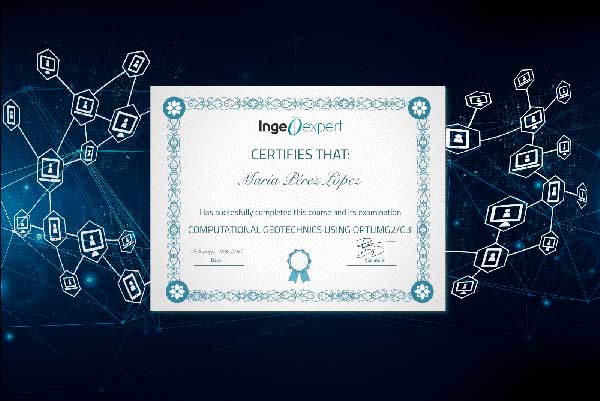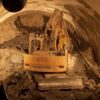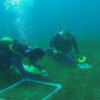Numerical modelling of rock fracturing processes
Online course |
|
50 hours / 6 weeks |
|
|
Dates: 14th of October to 25th of November |
| Standard | Unemployed Or Student |
| $367 | $270 |
Full-featured version of Irazu Geomechanical Simulation software included
In collaboration with Geomechanica
Introduction
In this course, we will provide an overview of numerical methods commonly used in rock engineering, including their limitations in dealing with problems involving large deformations and fracturing of discontinuous rock masses. Then, we will introduce the finite-discrete element method (FDEM), with a focus on theoretical aspects as well as computational and software implementation aspects. Finally, a large number of theoretical and practical case studies will be discussed with application to underground and surface mining, civil, and petroleum engineering.
Objectives
By attending this course, participants will learn about the basic concepts of numerical modeling for rock fracturing processes, available solutions, their pros and cons, as well as the FDEM method. Attendees will leave the course with a basic understanding of simulation approaches and in particular FDEM and how to apply FDEM to model complex engineering problems, such as underground excavations and slope stability analyses. Participants will learn how to build FDEM models in Geomechanica’s Irazu software, including the assignment of correct input parameters and postprocessing of the results.
Prerequisites: A basic understanding of rock mechanics and numerical modeling is required.
Course participants will receive a free, full-featured version of Geomechanica’s flagship Irazu simulation software for the duration of the course. IRAZU is a versatile 2D/3D finite-discrete element software package for the analysis of large deformations, fracturing, and stability in rock masses.The integration of various multi-physics solvers and advanced features into a single software package enables Irazu to be used for a wide range of geo-engineering applications, including but not limited to underground excavations, slope stability, tunnelling, dynamic analysis, mining, and reservoir geomechanics.
Limited places.
- Fundamental concepts of rock mechanics
- Intact rock
- Uniaxial compression behaviour
- Tensile behaviour
- Effect of confinement
- Failure criteria
- Discontinuities
- Geometrical properties
- Mechanical properties
- Rock mass
- Failure criteria
- Anisotropy and heterogeneity
- Constitutive models
- Linear elastic
- Elasto-plastic
- In-situ stresses
- Intact rock
- Introduction to numerical modelling in rock mechanics
- Main challenges of modelling rock mass behaviour
- Overview of numerical methods in rock mechanics
- Continuum
- Discontinuum
- Comparative analysis
- Simulation approaches for rock damage and fracturing
- Discontinuum approaches
- Hybrid methods
- ASSIGNMENT 1
- The finite-discrete element method
- History
- Governing equations and integration scheme
- Introduction to the core algorithms
- Linear elasticity and finite element deformation
- Contact detection and interaction between discrete bodies
- Damage and fracturing processes
- Advanced modelling features
- Discrete Fracture Networks (DFNs)
- Geostatic stresses
- Excavations
- Damping
- Meshing
- Overview of computer implementation (Irazu FDEM software)
- Heterogeneous, co-processing approach using CUDA
- Performance and scalability of GPU computations
- Introduction to the Irazu software and modelling guidelines
- Introduction to Irazu (software demo)
- Geometry creation and meshing
- Materials and boundary condition assignment
- Post-processing of simulation results
- Guidelines for a successful modelling campaign with Irazu
- Workflow and fundamental requirements of a numerical modelling campaign
- General guidelines
- ASSIGNMENT 2
- Introduction to Irazu (software demo)
- Analysis of fundamental rock mechanics processes: theory and modelling
- Laboratory tests on rocks
- Uniaxial and confined compressive strength tests
- Indirect tensile strength test
- Stresses around a cylindrical hole in an elastic medium (Kirsch solution)
- Laboratory tests on rocks
- Hands-on tutorials using Irazu 2D [Live session TBA, Q&A + recording the session]
- UCS model setup and analysis
- ASSIGNMENT 3
- Civil and mining engineering applications: case studies
- Underground excavations
- Stability of large hydroelectric caverns
- Dynamic rock mass failure at depth
- Underground nuclear waste disposal
- Analysis the Excavation Damaged Zone (EDZ) in Opalinus Clay
- 3D analysis of EDZ formation process
- Near-surface case studies
- Rock slope stability
- Mass mining
- Wave propagation
- Underground excavations
- Hands-on tutorials using Irazu 2D [Live session, Q&A TBA + recording the session]
- Excavation model
- ASSIGNMENT 4
- Thermo-hydro-mechanical (THM) modelling with FDEM
- Hydraulic solver
- Fracture flow: governing equations
- Numerical implementation
- Examples
- Thermal solver
- Thermal conduction, advection and convective heat transfer: governing equations
- Numerical implementation
- Examples
- Coupling effects and modelling approach
- Hydraulic solver
- THM applications: case studies
- Permeability assessment in fractured rock samples
- Effect of matrix permeability during hydraulic fracturing
- Fluid-injection-induced fault slip
- Well interaction during hydraulic fracturing in jointed rock masses
- Thermally induced borehole breakout
- ASSIGNMENT 5
- Hands-on tutorials and demo of 3D
- Rockbolts: theory and modelling
- Overview of analytical and numerical models for rock bolting
- Rockbolt logic in FDEM
- Modelling assumptions
- Governing equations and material models
- Pull-out test
- Analytical solution
- Modelling results
- Circular tunnel in an elastic medium
- Analytical solution
- Modelling results
- Application to rockbolting design in underground excavations
- Hands-on tutorials using Irazu 2D and 3D [Live session, Q&A TBA + recording the session]
- Final tutorial with Irazu
- Advanced post-processing with ParaView
- ASSIGNMENT 6
Dr. Omid Mahabadi
Omid Mahabadi is the president, CEO and a co-founder of Geomechanica. He holds a PhD degree in rock mechanics (civil engineering) from the University of Toronto. Omid specializes in development and application of advanced numerical simulation tools to solve rock engineering problems in civil, mining, and petroleum engineering. Omid was the lead developer of Y-Geo FDEM code and the sole developer of Y-GUI and GeoLab DAQ codes. He has authored or co-authored over 40 articles in peer-reviewed journals and conferences and acts as reviewer for many technical international journals and funding agencies in Canada.
Dr. Andrea Lisjak
Andrea Lisjak is the numerical modelling lead and a co-founder of Geomechanica. His area of expertise lies in the development and use of finite-discrete element numerical methods to investigate failure processes in rocks. He is the recipient of the 2015 Rocha Medal of the ISRM. He holds a PhD degree in Civil Engineering (rock mechanics) from the University of Toronto, Canada.
All of our courses are offered 100% online, through our intuitive Virtual Campus. Topics are taught through:
- – Videos
- – Interactive multimedia content
- – Live classes
- – Texts
- – Case studies
- – Evaluation exercises
- – Additional documentation
The content is updated in each new course edition, so that knowledge is acquired around the latest news and state-of-the-art geotechnical engineering technology.
One of the most interesting aspects of our courses is the use of live videoconferences, in which teachers and students interact in a continuous exchange of knowledge and problem solving. In addition to this, students can make use of the platform’s forum, a meeting point where they can interact with teachers and other students.
A tutoring system will also be established by email, which will resolve any possible doubts about the course, and which will serve as a point of connection for students with specific questions on each module.
Students can also download all course documentation, including texts and exercises.
This course is designed for geotechnical, geological, civil, mining, and petroleum engineers, as well as undergraduate and post-graduate students and researchers in the above fields. In particular, anyone who wishes to use or is considering using numerical methods for modelling rock fracturing, and in particular, FDEM to tackle challenging rock mechanics problems would benefit from this course.
Prerequisites: a basic understanding of rock mechanics and numerical modeling is required.
At the end of the course, and as accreditation of knowledge acquired and of the technical and practical training, students who correctly complete the corresponding evaluation tests of the geotechnical engineering course will obtain an academic certificate issued by Ingeoexpert. This digital certificate is protected by Blockchain technology, making it unique and tamper-proof, thus enabling companies to verify its authenticity.
It can also be downloaded by students, forwarded by email and shared on social networks, as well as embedded on any website. You can see an example here.
Participants will gain a deeper understanding of numerical rock mechanics, which is invaluable in the consulting and research world. This course will be a great asset in their resumes and will eventually lead to more career opportunities.
Full-featured version of Irazu Geomechanical Simulation software included
In collaboration with Geomechanica
Introduction
In this course, we will provide an overview of numerical methods commonly used in rock engineering, including their limitations in dealing with problems involving large deformations and fracturing of discontinuous rock masses. Then, we will introduce the finite-discrete element method (FDEM), with a focus on theoretical aspects as well as computational and software implementation aspects. Finally, a large number of theoretical and practical case studies will be discussed with application to underground and surface mining, civil, and petroleum engineering.
Objectives
By attending this course, participants will learn about the basic concepts of numerical modeling for rock fracturing processes, available solutions, their pros and cons, as well as the FDEM method. Attendees will leave the course with a basic understanding of simulation approaches and in particular FDEM and how to apply FDEM to model complex engineering problems, such as underground excavations and slope stability analyses. Participants will learn how to build FDEM models in Geomechanica’s Irazu software, including the assignment of correct input parameters and postprocessing of the results.
Prerequisites: A basic understanding of rock mechanics and numerical modeling is required.
Course participants will receive a free, full-featured version of Geomechanica’s flagship Irazu simulation software for the duration of the course. IRAZU is a versatile 2D/3D finite-discrete element software package for the analysis of large deformations, fracturing, and stability in rock masses.The integration of various multi-physics solvers and advanced features into a single software package enables Irazu to be used for a wide range of geo-engineering applications, including but not limited to underground excavations, slope stability, tunnelling, dynamic analysis, mining, and reservoir geomechanics.
Limited places.
- Fundamental concepts of rock mechanics
- Intact rock
- Uniaxial compression behaviour
- Tensile behaviour
- Effect of confinement
- Failure criteria
- Discontinuities
- Geometrical properties
- Mechanical properties
- Rock mass
- Failure criteria
- Anisotropy and heterogeneity
- Constitutive models
- Linear elastic
- Elasto-plastic
- In-situ stresses
- Intact rock
- Introduction to numerical modelling in rock mechanics
- Main challenges of modelling rock mass behaviour
- Overview of numerical methods in rock mechanics
- Continuum
- Discontinuum
- Comparative analysis
- Simulation approaches for rock damage and fracturing
- Discontinuum approaches
- Hybrid methods
- ASSIGNMENT 1
- The finite-discrete element method
- History
- Governing equations and integration scheme
- Introduction to the core algorithms
- Linear elasticity and finite element deformation
- Contact detection and interaction between discrete bodies
- Damage and fracturing processes
- Advanced modelling features
- Discrete Fracture Networks (DFNs)
- Geostatic stresses
- Excavations
- Damping
- Meshing
- Overview of computer implementation (Irazu FDEM software)
- Heterogeneous, co-processing approach using CUDA
- Performance and scalability of GPU computations
- Introduction to the Irazu software and modelling guidelines
- Introduction to Irazu (software demo)
- Geometry creation and meshing
- Materials and boundary condition assignment
- Post-processing of simulation results
- Guidelines for a successful modelling campaign with Irazu
- Workflow and fundamental requirements of a numerical modelling campaign
- General guidelines
- ASSIGNMENT 2
- Introduction to Irazu (software demo)
- Analysis of fundamental rock mechanics processes: theory and modelling
- Laboratory tests on rocks
- Uniaxial and confined compressive strength tests
- Indirect tensile strength test
- Stresses around a cylindrical hole in an elastic medium (Kirsch solution)
- Laboratory tests on rocks
- Hands-on tutorials using Irazu 2D [Live session TBA, Q&A + recording the session]
- UCS model setup and analysis
- ASSIGNMENT 3
- Civil and mining engineering applications: case studies
- Underground excavations
- Stability of large hydroelectric caverns
- Dynamic rock mass failure at depth
- Underground nuclear waste disposal
- Analysis the Excavation Damaged Zone (EDZ) in Opalinus Clay
- 3D analysis of EDZ formation process
- Near-surface case studies
- Rock slope stability
- Mass mining
- Wave propagation
- Underground excavations
- Hands-on tutorials using Irazu 2D [Live session, Q&A TBA + recording the session]
- Excavation model
- ASSIGNMENT 4
- Thermo-hydro-mechanical (THM) modelling with FDEM
- Hydraulic solver
- Fracture flow: governing equations
- Numerical implementation
- Examples
- Thermal solver
- Thermal conduction, advection and convective heat transfer: governing equations
- Numerical implementation
- Examples
- Coupling effects and modelling approach
- Hydraulic solver
- THM applications: case studies
- Permeability assessment in fractured rock samples
- Effect of matrix permeability during hydraulic fracturing
- Fluid-injection-induced fault slip
- Well interaction during hydraulic fracturing in jointed rock masses
- Thermally induced borehole breakout
- ASSIGNMENT 5
- Hands-on tutorials and demo of 3D
- Rockbolts: theory and modelling
- Overview of analytical and numerical models for rock bolting
- Rockbolt logic in FDEM
- Modelling assumptions
- Governing equations and material models
- Pull-out test
- Analytical solution
- Modelling results
- Circular tunnel in an elastic medium
- Analytical solution
- Modelling results
- Application to rockbolting design in underground excavations
- Hands-on tutorials using Irazu 2D and 3D [Live session, Q&A TBA + recording the session]
- Final tutorial with Irazu
- Advanced post-processing with ParaView
- ASSIGNMENT 6
Dr. Omid Mahabadi
Omid Mahabadi is the president, CEO and a co-founder of Geomechanica. He holds a PhD degree in rock mechanics (civil engineering) from the University of Toronto. Omid specializes in development and application of advanced numerical simulation tools to solve rock engineering problems in civil, mining, and petroleum engineering. Omid was the lead developer of Y-Geo FDEM code and the sole developer of Y-GUI and GeoLab DAQ codes. He has authored or co-authored over 40 articles in peer-reviewed journals and conferences and acts as reviewer for many technical international journals and funding agencies in Canada.
Dr. Andrea Lisjak
Andrea Lisjak is the numerical modelling lead and a co-founder of Geomechanica. His area of expertise lies in the development and use of finite-discrete element numerical methods to investigate failure processes in rocks. He is the recipient of the 2015 Rocha Medal of the ISRM. He holds a PhD degree in Civil Engineering (rock mechanics) from the University of Toronto, Canada.
All of our courses are offered 100% online, through our intuitive Virtual Campus. Topics are taught through:
- – Videos
- – Interactive multimedia content
- – Live classes
- – Texts
- – Case studies
- – Evaluation exercises
- – Additional documentation
The content is updated in each new course edition, so that knowledge is acquired around the latest news and state-of-the-art geotechnical engineering technology.
One of the most interesting aspects of our courses is the use of live videoconferences, in which teachers and students interact in a continuous exchange of knowledge and problem solving. In addition to this, students can make use of the platform’s forum, a meeting point where they can interact with teachers and other students.
A tutoring system will also be established by email, which will resolve any possible doubts about the course, and which will serve as a point of connection for students with specific questions on each module.
Students can also download all course documentation, including texts and exercises.
This course is designed for geotechnical, geological, civil, mining, and petroleum engineers, as well as undergraduate and post-graduate students and researchers in the above fields. In particular, anyone who wishes to use or is considering using numerical methods for modelling rock fracturing, and in particular, FDEM to tackle challenging rock mechanics problems would benefit from this course.
Prerequisites: a basic understanding of rock mechanics and numerical modeling is required.
At the end of the course, and as accreditation of knowledge acquired and of the technical and practical training, students who correctly complete the corresponding evaluation tests of the geotechnical engineering course will obtain an academic certificate issued by Ingeoexpert. This digital certificate is protected by Blockchain technology, making it unique and tamper-proof, thus enabling companies to verify its authenticity.
It can also be downloaded by students, forwarded by email and shared on social networks, as well as embedded on any website. You can see an example here.
Participants will gain a deeper understanding of numerical rock mechanics, which is invaluable in the consulting and research world. This course will be a great asset in their resumes and will eventually lead to more career opportunities.
8 reviews for Numerical modelling of rock fracturing processes
More info
Finish this course and get a certificate based on Blockchain
Numerical modelling of rock fracturing processes

Blockchain technology makes the certificate incorruptible, enabling companies to verifiy its autenticity.
Numerical modelling of rock fracturing processes
| $367 | $270 | |
| Get more information |





Alex –
I highly recommend the “Numerical modelling of rock fracturing process” course. Omid and Andrea have developed a cutting-edge software which is user-friendly and capable of solving 2D or 3D civil or mining engineering applications which include coupled mechanical, hydraulic, transport and thermal simulations.
The course modules are explained in detail and answers and explanations have been provided to all questions.
Ahmad Mubarak –
Delighted to attend this course, it gave me new insights into new modelling techniques of structures in rock and the modelling of failure processes and rock fractures. Recommended for anyone in the field of rock mechanics.
Arturo Maldonado –
It was very interesting and learnt lots of rock mechanics and numerical modelling. Thanks very much.
Seyed Mohammad Hosein Seyed Ghafouri –
It was great experience learning about numerical modeling of rock fracturing. The professors were knowledgeable and the platform was easy to use.
Nicolás Díez Cruz –
The course is very well organized and it captures your interest really fast. It gives a proper introduction to the Finite-Discrete Element Method and consequently to the Irazu Software and its applications in civil and mining engineering. The professors were really helpful and demonstrated the huge knowledge they have about what is teached. I highly recommend this course to any civil or mining engineer interested in analysing problems related with geomechanics.
Jamal Moutraji –
In general ,the course was usful for me as i am geotechnical expert.
Osvaldo Vitali –
Excellent course. I highly recommend.
Silum Teaghes Ghebreyesus –
Well-structured course beginning with the fundamentals of rock mechanics and introducing FDEM method while gradually adding complexity. Extra References at the end of each module are helpful for further understanding the topic. Administrative and subject matter questions are answered clearly and on time. All these at an affordable price. I benefitted a lot. Thank you.